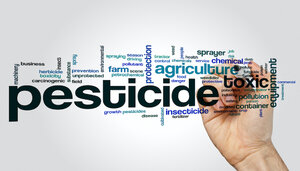
Food Safety News
Breaking news for everyone's consumption
Menu
HomeOutbreaksRecallsDirectoryEventsAbout UsMedia KitContact Us
 Injunction sought against EPA regarding ban on farm pesticide chlorpyrifos
Injunction sought against EPA regarding ban on farm pesticide chlorpyrifosBy News Desk on February 15, 2022
If you’ve ever had to “walk the beans,” you probably appreciate the use of the farm pesticide chlorpyrifos, which the Environmental Protection Agency (EPA) last August said it will ban growers from using around food crops in the future.
Agricultural groups are seeking a court injunction against the ban and as recently as this past Wednesday, the Food and Drug Administration released a guidance document to help food producers and processors who handle foods that may contain residues of the pesticide chemical chlorpyrifos.
EPA’s concern is possible neurological damage chlorpyrifos may cause, especially in pregnant women. Agricultural interests, however, say it can be applied safely and alternatives don’t exist.
Without effective pesticides, American agriculture would likely have to step back to the day when farm jobs included pulling weeds out of the fields by hand, which was known as “walking the beans.”
FDA’s new guidance is for the period after the EPA tolerances expire, so when a food that contains chlorpyrifos residues is not deemed unsafe solely based on the presence of the residue as long as the chlorpyrifos was applied lawfully and before the tolerance expired, and the residue does not exceed the level permitted by the tolerance that was in place at the time of the application.
Ag groups representing thousands of farmers and farmer-owned cooperatives that say they will be harmed by the EPA’s ruling to revoke all tolerances of chlorpyrifos are taking legal action against the agency: They say their challenge is over “EPA’s disregard for its own science confirming the crop protection tool can be used safely, effectively, and without dietary or environmental risk.”
Brad Doyle, a soy farmer from Arkansas and president of the American Soybean Association said: “EPA’s proposed interim decision back in December 2020 for the re-registration of chlorpyrifos found 11 high-benefit, low-risk crop uses that the agency was confident ‘will not pose potential risks of concern.’ How can they now deny all uses, even when the court gave them options for keeping those found safe?”
The agricultural stakeholders say they are taking legal action by first seeking an injunction of the rule to prevent the first wave of significant, irreparable damage the chlorpyrifos revocation would cause if it were to take effect on the Feb. 28 implementation date. The groups are ultimately seeking vacatur of the rule where it conflicts with what they describe as well-established, properly developed science — specifically, the 11 uses found safe.
Farmers prioritize safe use of pesticides for a multitude of reasons related to safe food production and stewardship. The revocation rule undermines their efforts by removing a critically needed tool, according to advocates.
“Farmers are highly motivated to use pesticides judiciously as part of their commitment to produce safe, nutritious foods while also being good stewards of the land. Taking away this tool takes us backward by increasing the use of less effective pesticides to compensate and, in some cases, sacrificing crops that supply our food when no other defense exists against certain pests,” said American Farm Bureau President Zippy Duvall.
Stakeholder groups have filed formal objections highlighting the significant harms that would result from the rule and have asked for formal hearings and a stay of the rule until these objections can be addressed. They say EPA’s failure to consider these concerns or rescind the rule would have major consequences for growers and the food, fuel, and fiber they supply across multiple crops. For many growers, chlorpyrifos is the only, or one of very few, tools to protect crops from certain pests. Losing chlorpyrifos would expose those growers to hundreds of millions — to billions — of dollars in potential damages.
The revocation rule also requires food holders to provide retroactively-required application documents, which could result in the destruction of millions of dollars of perfectly safe food over a paperwork issue, advocates say. These requirements come despite EPA’s acknowledgement that, “considering food exposures alone, the agency did not identify risks of concern.” Of additional concern to growers is that EPA is also discontinuing uses when an actual food crop is not present, such as to tree trunks before the fruit has developed, on dormant fields, or to crops subject to further processing in which residues would not be detected.
“Based on EPA’s own safety assessment of chlorpyrifos for sugarbeets, our growers have depended on this effective and essential product to protect their crops from certain disaster while providing safe, high-quality sugar from American consumers,” said Nate Hultgren, president of American Sugarbeet Growers Association.
If EPA does not listen to its own career scientists when making these decisions, America’s growers and food suppliers fear what the future of farming looks like.
“It is unfortunate that we are forced to take these drastic steps. However, with the revocation of such an important chemistry in our industry, our growers stand to suffer irreparable harm. Michigan, with almost 5 million sweet and tart cherry trees, grows 70-75 percent of the total U.S. production of tart cherries and close to 20 percent of the total production for sweet cherries. Chlorpyrifos is critical to the Michigan cherry industry, as there are no alternative products that effectively control trunk borers,” said Julie Gordon, president of the Cherry Marketing Institute.
In October 2021, more than 80 agricultural groups filed formal objections to EPA’s rule revoking all tolerances of chlorpyrifos. Stakeholders, by law, can object to pesticide tolerance changes or cancellations, and the EPA Administrator must then respond. The groups asked EPA for evidentiary hearings and to stay implementation of the rule until objections could be formally considered and addressed by the agency. The objections, hearing requests, and stay requests have not been addressed by EPA to date. A full copy of the coalition stakeholder objection letter can be found here.
Joining the lawsuit are: Red River Valley Sugarbeet Growers Association; U.S. Beet Sugar Association; American Sugarbeet Growers Association; Southern Minnesota Beet Sugar Cooperative; American Crystal Sugar Company; Minn-Dak Farmers Cooperative; American Farm Bureau Federation; American Soybean Association; Iowa Soybean Association; Minnesota Soybean Growers Association; Missouri Soybean Association; Nebraska Soybean Association; South Dakota Soybean Association; North Dakota Soybean Growers Association; National Association of Wheat Growers; Cherry Marketing Institute; Florida Fruit and Vegetable Association; Georgia Fruit and Vegetable Growers Association; National Cotton Council of America; and Gharda Chemicals International Inc.
Food Quality Protection Act 10X (FQPA 10X) high benefit uses identified by EPA include alfalfa, apples, asparagus, cherries, citrus, cotton, peaches, strawberries, soybeans, sugarbeets, and wheat across various states.
(To sign up for a free subscription to Food Safety News, click here.)
Tags: chlorpyrifos, EPA, FDA, pesticides




